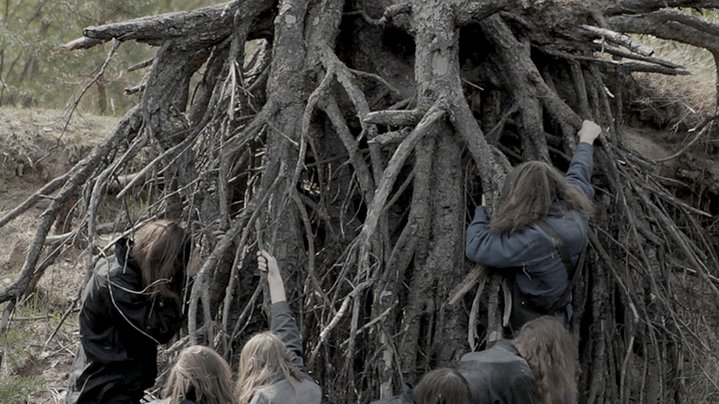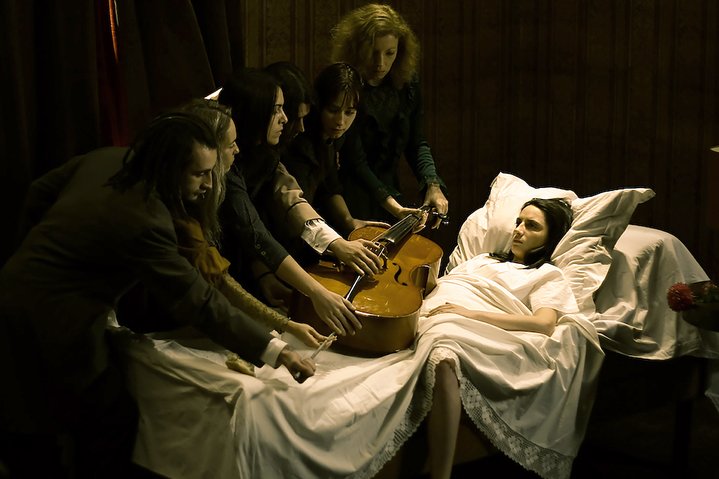Provmyza: performance on the brink of existence
Provmyza, an artistic duo from Nizhny Novgorod with a chilling and uncompromising oeuvre, is preparing a new video work.
An impeccably constructed baroque style is the stage setting for two figures: a pale young woman dressed in sumptuous black lace, and a naked male figure sinewy and haggard, slumped on an unmade bed, genitalia on display, while his head is wrapped in white cloth. That image alone is astonishing, even before the corpse-like man emits a blood-curdling scream to the limits of his vocal cords’ capacity. These heavily loaded triggers push viewers out of their comfort zone and set off a chain reaction of internal questioning about the constraints of human nature, the transition between life and death, the dichotomy between classical and contemporary, sacred and profane, disgusting and beautiful.
All these ruminations arise from just a few seconds of a video recording a live performance by Nizhny Novgorod-based group Provmyza, a label blending the names of its two members Galina Myznikova (b.1968) and Sergey Provorov (b. 1970) who have been straddling the interdisciplinary territory of performance, video, installation and beyond, since the 1990s, achieving an unparalleled mastery and global renown. The abovementioned extract comes from one of their latest works, ‘Memento Mori Tomb’ – a 20-minute video.
The theatrical performance continues on a dramatically lit stage with minimal non-verbal actions. The man, or rather, the unidentified male body, is dragged across the stage and the woman munches a pasty, crumbly substance. She raises a wooden coffin from beneath the floorboards, smearing it in yet another unidentified substance. She eventually departs through the floorboards and then the final chord strikes. It summarizes Provmyza’s genius. Mixing pristine technical achievement, theatrical showmanship and philosophical depth, the entire set begins to slowly self-destruct. The walls crumble, the furniture cracks and everything is in motion until it becomes apparent that the world on which the viewer's attention was transfixed for the past 15 minutes is being crushed by a gigantic hydraulic press. The highlight of the show comes when it ends and the lights come on, revealing the entire mechanisms of the stage and set, destroyed and laid bare. The audience is left astounded, having just been subjected to the artists’ “research of the limits of the capability of human perception in extreme audial, visual and emotional conditions”.
It calls into question what is construction and what is reality, as well as the simultaneous fear and glee of witnessing destruction. Characteristic of the colossal oeuvre of this artistic duet, this work is highly complex, problematic, philosophically monumental, and by no means easy on the viewer. As the artists proclaim: “Slowing down time until it becomes intolerable, deadly tedious and boring, that is our foremost aim.”
Other works of note include ‘Homo Sacra Res Homini’ (2013) where a hanged man swings like a wrecking ball from the ceiling, gradually destroying the set with the weight of his dead body, as well as ‘Pitter-Patter’ (2009), a poignant video homage to Henry Peach Robinson’s morbid 1858 ‘Fading Away’ photograph. This notorious image of a dying young girl and her mourning relatives has been re-staged as an operatic performance. Their first foray into opera with ‘Marevo’ (2012) won Russia’s prestigious Innovation Art Prize. The two artists were chosen, among others, to represent Russia at the 51st Venice Biennale in 2005. Their work ‘Idiot Wind’ was an artificially created gale which blew visitors off their feet upon attempting to enter the pavilion.
Their newest work, ‘Oratorium Sarx Soma’, is a filmed performance currently in preparation for an exhibition in Nizhny Novgorod’s Arsenal art centre (18 March – 10 May). I managed to interview them during the final throes of preparations. “The particular combination of performers and technical conditions provides the opportunity for us to attempt to rethink time anew. With a specially written score for two ‘super-intense’ voices, we will create an unbearable sound atmosphere,”was the way they put it.
It is being prepared in the artist’s home town of Nizhny Novgorod, hosted by the local branch of the NCCA (National Centre for Contemporary Arts). Something that is notable in the Russian context, is that these renowned contemporary artists remained faithful to their provincial roots, unlike many colleagues who relocate to the capital in pursuit of a much more promising cultural landscape.
“In our opinion, the urge to unite is instigated precisely by the existential possibility of overcoming co-existence,” is the way they explain the mechanics of their collaborative process. And it becomes evident that there is no distinction between the final work and what the “behind the scenes” is, which is maybe the key difference between theatre and performance. Their entire process is a metaphysical experiment, from conception, development, planning, organisation, collaboration with actors, performers and the audience. It is an inextricable philosophical quest.
Oratorium Sarx Soma
Arsenal (Volgo-Vyatsky branch of the National Centre for Contemporary Art)
Nizhny Novgorod, Russia
18 March – 10 May 2020










